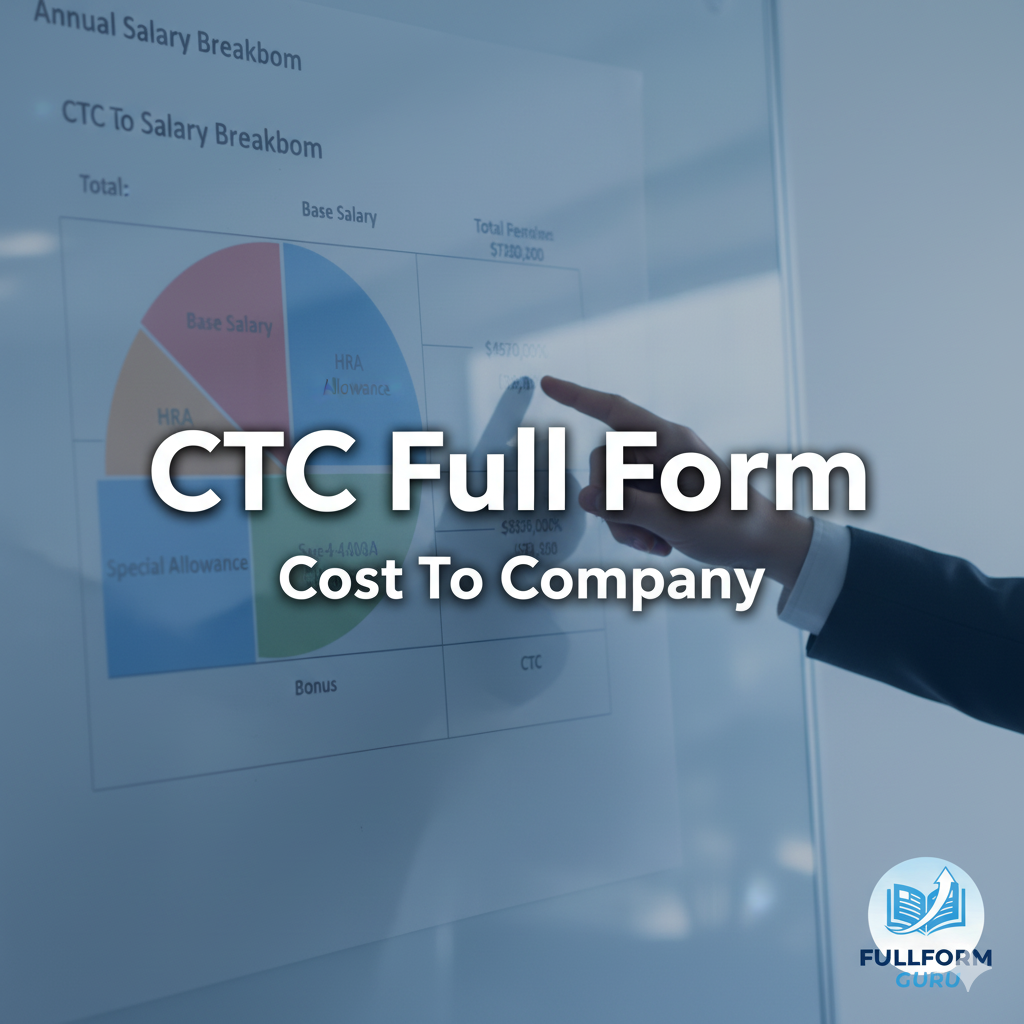CTC Full Form – Full Form of CTC

CTC Full Form: Meaning, Components, and How to Understand Your Salary
Introduction
The CTC Full Form is Cost to Company. When people receive a job offer, one of the first things they notice is the salary package. However, the figure mentioned in the offer letter may not always be the exact amount that goes into their bank account every month. It is because organizations present salaries in terms of CTC, which stands for Cost to Company. Understanding CTC is valuable for both employees and employers, as it shows the complete financial investment a company makes in an employee.
Knowing about CTC Full Form helps job seekers and employers see the Full financial picture behind a salary offer. This article explains the Full Form of CTC, its meaning, the different components included, and how employees can better understand their salary structures.
CTC Full Form and Meaning
The CTC Full Form is Cost to Company. It represents the total amount of money an organization spends on an employee in a year. It not only includes the cash salary received by the employee but also additional expenses such as allowances, bonuses, benefits, retirement contributions, and insurance.
In simple terms, CTC is the sum of:
- Direct benefits — cash in hand, such as basic pay and allowances
- Indirect benefits (non-cash perks such as insurance or subsidies)
- Savings contributions (such as pension or retirement funds)
This breakdown shows how CTC consists of both cash and non-cash elements that form the total cost.
Role and Importance of CTC (Why it Matters)
CTC plays a vital role in shaping employment decisions for both companies and workers.
For employees:
- It helps in understanding how much money they will actually take home each month.
- It creates clarity about the benefits and long-term savings included in the package.
- It allows comparison between job offers to make informed career choices.
For employers:
- It shows the actual cost of hiring and retaining employees.
- It helps plan budgets for recruitment and payroll management.
- It ensures transparency while negotiating salaries with potential candidates.
Knowing the structure of CTC prevents confusion, builds trust between employer and employee, and supports good financial planning.

Key Components of CTC
CTC consists of multiple elements:
- Basic Salary – The fixed portion of pay that forms the foundation of the salary structure.
- House Rent Allowance (HRA) – Provided to cover living or rental expenses.
- Conveyance Allowance – Travel-related expenses for commuting.
- Medical Allowance – Healthcare-related costs and insurance contributions.
- Performance Bonus – Incentives linked to employee performance or company profits.
- Provident Fund/Retirement Contribution – Savings deposited by the company for long-term employee benefits.
- Insurance Premiums – Health, accident, or life insurance funded by the employer.
- Other Perks – Subsidized meals, travel reimbursements, or company-provided facilities.
Understanding the CTC Full Form at this stage helps employees see how benefits and deductions shape their real monthly income.
Mini Table: Example of a CTC Breakdown
| Component | Example Annual Value (in neutral figures) |
| Basic Salary | 30,000 units |
| House Rent Allowance (HRA) | 12,000 units |
| Conveyance Allowance | 6,000 units |
| Medical Allowance | 5,000 units |
| Provident Fund Contribution | 8,000 units |
| Insurance Premiums | 4,000 units |
| Performance Bonus | 10,000 units |
| Total CTC | 75,000 units |
This table is a sample illustration to show how CTC combines multiple parts to form the final figure. The actual in-hand income will be lower than the CTC because some benefits are non-cash or deducted for savings.
How to Understand CTC and In-Hand Salary
The most common confusion arises when employees notice that their in-hand salary is lower than the CTC. Understanding the CTC Full Form helps identify which components make up monthly pay and which contribute to perks or savings. To understand this difference:
- Typical in-hand calculation (simplified):
In-hand salary = Gross monthly salary − employee deductions (taxes + employee PF + professional tax)
Example (neutral figures): Gross monthly salary = 5,000 units; employee PF = 500 units; tax = 600 units; other deductions = 100 units. Estimated take-home = 5,000 − (500 + 600 + 100) = 3,800 units.
- Some benefits, such as insurance, bonuses, or retirement savings, are part of CTC but are not received as cash each month.
- Employers sometimes provide one-time or annual perks that do not appear in the monthly pay.
Employees should carefully check the salary structure in their offer letters to clearly understand their take-home pay.
How CTC Affects Career and Financial Planning
Thinking about CTC makes it easier to compare offers and plan financially:
- Budgeting: Employees can plan their expenses better when they know their actual monthly income.
- Comparing Job Offers: Candidates can make fair comparisons between offers only when they study the CTC structure in detail.
- Long-Term Savings: Contributions to retirement or provident funds ensure financial security in the future.
- Career Growth: Awareness of salary components allows professionals to negotiate for benefits that matter most to them.
By keeping the CTC Full Form in mind, professionals can balance present spending with future financial security.

Practical Tips to Manage and Negotiate CTC
Employees can use these strategies to make the best out of their salary package:
- Always request a detailed salary breakup before accepting an offer.
- Focus on both in-hand salary and long-term benefits such as retirement funds or insurance.
- Negotiate for allowances or perks that align with your lifestyle and career goals.
- Do not look only at the highest CTC figure; instead, calculate the monthly cash flow.
- Consider non-financial benefits such as work-life balance, flexibility, and chances for career growth.
Comparison with Gross Salary and Net Salary
To avoid confusion, it is essential to understand how CTC differs from other salary terms.
| Term | Meaning |
| CTC | Total cost incurred by the company, including all benefits and savings. |
| Gross Salary | Salary before tax deductions, and usually before employer contributions and some benefits. |
| Net Salary | Final in-hand salary after all deductions like taxes, employee provident fund contributions, and income tax. |
This comparison highlights that CTC is the broadest figure, while net salary is what actually reaches the employee’s account.
Common Myths About CTC
Many employees misunderstand CTC due to common myths. Below are clarifications:
- Myth: CTC is the same as take-home monthly income.
- Fact: The in-hand monthly income is generally less than the CTC because of deductions.
- Myth: A higher CTC always means higher income.
- Fact: It depends on how much of the package is direct cash versus indirect benefits.
- Myth: CTC only includes monthly income and bonuses.
- Fact: It also covers insurance, retirement contributions, and other perks.
Conclusion
Understanding the CTC Full Form, which means Cost to Company, helps individuals make informed decisions about their income and professional growth. It explains the overall expenses of a company for an employee, which consist of benefits and savings. By learning how CTC is structured, professionals can better manage their finances, negotiate job offers more effectively, and plan for long-term stability.
When analyzing CTC, focus not only on the numbers but also on the value of each component. A well-structured package can support your present needs while building a secure future. Remember, knowledge of CTC is not only about salary figures; it is a tool for better financial planning and stronger career growth. Stay informed, stay confident, and let your understanding of CTC guide you toward professional success.







